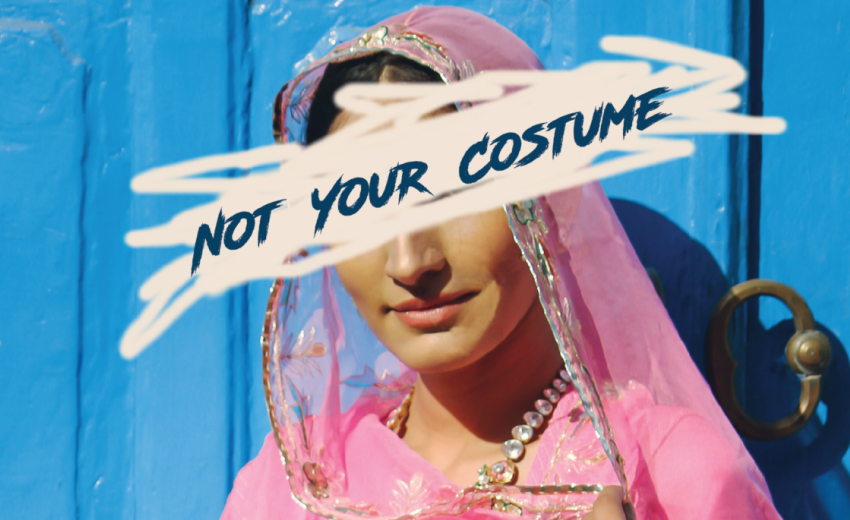Austin, TX recently hosted the Austin City Limits Festival, an annual music festival where over 450,000 people flock to our version of Central Park. Blogs and magazines showcased “hip festival wear” and attendees followed suit and put on mehndi, facepaint, Native American Muscogee headdresses, and golden arrow temporary tattoos. The scene of white women wearing “tribal” and “ethnic” artifacts as costumes revived within me questions of cultural appropriation and minority rights.
What is Cultural Appropriation?
What is cultural appropriation? How does it affect Sikhs? Do I culturally appropriate? How do I resist cultural appropriation? These are all questions that have plagued me for a while.
Earlier this year, I attended a panel called “Cultural Appropriation and the Ties to Colonialism and Capitalism,” hosted by Boss Babes here in Austin. It was only then that I felt I understood what cultural appropriation actually meant.
The panel of diverse men and women came to the consensus that cultural appropriation is when a dominant group adopts cultural elements of a marginalized people.
A very obvious example, panelist Dr. Skyler Walkes said, is when Kim Kardashian wore cornrows and renamed them “boxer braids.” White culture has historically attached negative stereotypes to cornrows and debased them as “tribal,” she said. But the second they are promoted by a white celebrity and redefined as “glamorous” by Eurocentric magazines, they become celebrated.
While not to the same extent, I feel like a similar thing has happened with the turban. In the West, the Sikh dastar is commonly connoted with “terrorism” and many Sikh women and men have been physically, emotionally, and socially attacked for their dastars. But the moment they are claimed by the powerful, white elite, they become celebrated artifacts. For instance, high fashion runway models don turbans and usher in statements like “turbans are the hottest spring statement”.
“Dominant identities are seen as ‘edgy’ or ‘groundbreaking’ for taking something that marginalized communities have been doing for a while, and have been doing in the face of negative stereotypes,” said a panelist.
Or consider, the cultural appropriation of body hair. (Granted everyone has body hair but the way it has been culturally relegated to fringe spaces makes it an interesting case.) A brown women’s body hair, her unshaven armpits and legs, as embracing her natural-self, accepting Guru’s hukham, or being amrit dhari, is seen as “backwards,” “uncivilized” and “uncouth” by the dominant power structure. So, many Sikh girls are teased and bullied for their hairy legs. But, when a few white women (mostly celebrities) adopt the practice of keeping and showing off their body hair, they are seen as innovative and pioneering. “These celebrities are the first in line to encourage the mantra ‘hair’s just hair’ with their au naturel body hair in full bloom,” writes style blogger Jason Pham. First in line? Since when? We’ve been keeping our kesh for hundreds of years.
In general, women of color are often the least celebrated, most scrutinized, and most disrespected marginalized group, said Dr. Walkes. “And that is despite of what is being done in mainstream society is modeled on what they have already done.”
Why Does Cultural Appropriation Happen?
So, why does white America engage so readily in cultural appropriation? Several reasons.
First, cultural appropriation goes hand-in-hand with colonialism and capitalism.
“Cultural appropriation, exploitation, empiring, colonialism, micro and macro aggression upon marginalized and targeted communities is a continuation of imperialism and colonial expansion,” said panelist Jesse Silva. “It wasn’t enough that they took our homes. Now they’re stealing our food and clothes and selling them back to us.” The system economically profits by commoditizing our culture; think mala beads being sold for ridiculous amounts of money, or Sikh kirtan being played in yoga studios, or Punjabi clothing/Sikh instruments/Sikh weapons being sold at boutique stores as “exotic imports”.
The second reason for cultural appropriation, according to the panel: white Americans do not have a unique culture of their own. “Dominant cultural groups tend to be devoid of a unique culture because in order to be ‘white’ or have power, you have to give of yourself,” said Silva. “You have to be flexible to retain power and the only way you can do that is to constantly let go. Let go of your history, let go of your language, and let go of your knowledge.” This gap and void leads white America to start appropriating and taking away from other groups that are more rich in culture.
The Harm of Cultural Appropriation
“Cultural appropriation breeds trauma,” said Dr. Walkes. “Every time you see a piece of your culture being exploited, feelings of devaluation are reintroduced. You are being told that who you are and what you are is not valuable unless it is commodifiable and only then, if it is separated from your identity.”
Like, my long uncut kesh and my braids aren’t valuable until shampoo companies realize they can make money off of them and then start to celebrate it. Or my bushy eyebrows are ridiculed until cosmetic companies realize they can sell more product if they promote natural, full eyebrows. While these cultural artifacts are being promoted by the powers that be, they ultimately have been detached from me as a person. Sikh women are not celebrated because of their kesh or natural bodies; the white, elite, non-Sikh women who adopt these trends are the ones celebrated.
My hairy armpits are still a threat to the hair removal industry, and until they find a way to make money off them, I will continued to be shunned as a “dirty minority”. The West may keep calling Sikh women who wear chunis or dastars “backwards” until the fashion industry finds a way to make them mainstream and make money off them. As Dr. Walkes said, “The oppressed understand oppression as normal. They think, ‘There is something shameful, not celebratory of my difference, because it is not part of the dominant narrative.’ ”
You have the Agency to Push Back Against Cultural Appropriation
Some of us felt shame growing up and walking with our immigrant parents in the mall with their suits, chunnis, dastars, and beards. We were told by the power structures to have shame around our food, our prayers, our kirtan, our music, our clothing, our Gurmukhi, and our Punjabi language. “We grew up in a system where a white, middle school girl, when interacting with something she had never seen before, automatically thought she was better than it,” said panel moderator Jasmin Patel.
Surrounding this shame, some of us Punjabi Sikhs tried hard to assimilate and to adopt a white, non-Sikh lifestyle. “Those who are marginalized often dissociate themselves from their authentic identity,” said Dr. Walkes. “There is a degree of self-hate in assimilation.” Growing up, I saw some of my Sikh girl friends dye their hair blond, remove all their body hair, accentuate their white features, quickly change out of their suits after Gurdwara, not go to Gurdwara at all, refuse to speak Punjabi, bleach their skin, and cut their hair short. They were ethnic without being too ethnic. Assimilation as a survival tactic morphed into a way to become “white” and to gain power in the system.
“In the name of ‘respectability politics’ we remove any traces that give credence to our authentic being, whether they be habits or customs, and ultimately, perpetuate the existing white power structures through compliance,” said Dr. Walkes.
So, what can you do, at a personal level to push back against cultural appropriation? Against colonization? What can you do to embrace your Sikh sovereignty?
Know Your History
“So many young women are struggling to reconcile with their authentic selves because there has been so much erasure of prideful roles or roles they can celebrate in history,” said Dr. Walkes about black women. The same can be said of Sikh women and Sikhs in general. Our history is not taught or was not recorded. So, the first step is to go learn about our history, ground yourself in the stories of powerful Sikh women, and surround yourself with those who are creating Sikh histories today.
Sikh women, and Sikh women of color, are marginalized at intersections: many of us are oppressed because of our race, caste, gender, sex, religion, and immigration status. So, we must seek out these complexities in our history. It is our responsibility to educate ourselves. We won’t learn this history at schools because our colonizers are our teachers.
Embrace Your Culture
“Culture and history remind us of ourselves. They are our identity and our life. Decolonize your diet, food, spirit, and mind,” said Silva. Start incorporating Sikh elements into your lifestyle. Consider learning gurbani, start meditating, understanding Gurdwara practices, listening to kirtan, learning how to make prashad, embracing a Sikh sangat, and wearing your 5 Ks with pride. What’s your personal culture? What’s your Sikh culture?
Challenge Yourself
Looking inwards and critiquing your own thoughts and behaviors is a powerful tool in creating new paradigms of personal Sikh sovereignty. “You have to be willing to be uncomfortable and examine your own shit,” said a panelist. “Think about questions like: Where are the privilege and power dynamics in your reality? How are you complicit in oppressive behavior? We can write letters to representatives all day, but if we don’t examine it within ourselves, nothing’s going to change. If you’re going to disrupt, interrupt, and interrogate privileged dynamics – it’s a lifetime’s work. You can’t just march on Saturday and be done with it.”
Remember
“We are people of resistance and resilience. There is no possible way that I would be here today without everything that is bountiful of my people. Despite colonization, destruction, wars, laws, policies, and conquest, we persist,” said Silva about his Mexican heritage.
“Everything your people were built upon and founded in, everything that fueled their spiritual beings – it lives in you. It is that gut wrenching voice that tells you, ‘Resist! Resist! You are resilient! F*#k some shit up!’ ”





